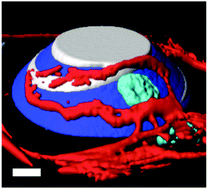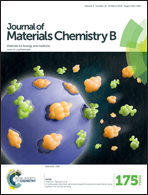Functionalizing micro-3D-printed protein hydrogels for cell adhesion and patterning†
Abstract
The extracellular matrix has been shown to profoundly influence both cell morphology and numerous cellular processes – including adhesion, differentiation, and alignment – through a range of chemical, mechanical, and topographical features. In these studies, we investigate a versatile platform for functionalizing micro-3D-printed (μ-3DP) protein hydrogels via multiphoton excitation of benzophenone-biotin, a photoactivatable ligand capable of reacting with the hydrogel matrix, which is subsequently linked to a biotinylated cell-adhesive peptide through a NeutrAvidin® bridge. This functionalization strategy is potentially applicable to a broad range of hydrogel platforms, enabling biomolecules to be precisely patterned at specified locations within 3D materials. As proof-of-concept of this strategy's utility, we demonstrate that chemical modifications can be made to μ-3DP protein hydrogels that enable Schwann cells to be patterned without altering the mechanical or topographical properties of the hydrogel to an extent that influences SC cell adhesion. The ability to independently control potential cellular cues within in vitro cellular microenvironments is essential to investigating decoupled effects of biomaterial properties on cell-matrix interactions. In addition, we demonstrate feasibility for generating arbitrary immobilized chemical gradient profiles, a result that opens important opportunities for understanding and controlling haptotactic behaviors, such as directed migration, that are key to various tissue regeneration applications.


 Please wait while we load your content...
Please wait while we load your content...